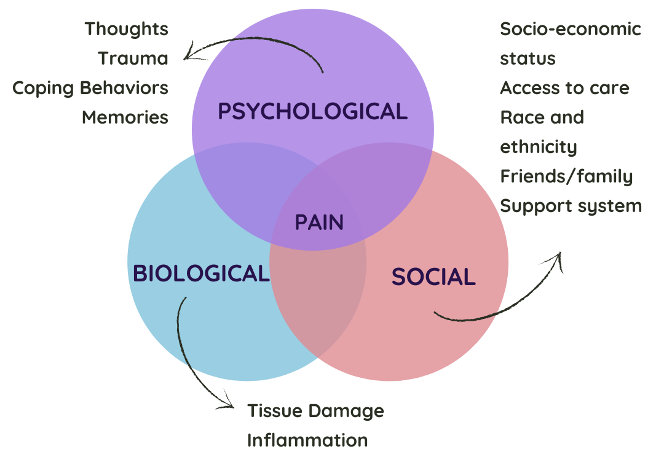How Do Racial Disparities Relate to Chronic Pain?
Chronic, persistent pain is estimated to affect over 100 million American adults and is among the leading global causes of reduced quality of life. NFL players are no exception as they experience high levels of physical trauma during their playing years, which puts former players at risk for chronic pain and substantial psychosocial distress.
Our recent study in the journal Pain examines chronic pain and racial disparities.
We know that race and ethnicity are factors that contribute to differences in pain experiences. For example, research has shown that people of color who experience pain are often under-treated.
Our researchers looked at the biological, psychological, and social factors (also called biopsychosocial factors) that impact how former players experience pain. This graphic illustrates some examples:

Our recent paper is based on survey data from 3995 former NFL players which posed questions about age, race, body mass index (BMI), playing history, pain, social support, sleep, and other current health conditions. We examined how players reported on the intensity of their pain, and the extent to which pain interfered in their daily activities. We also looked separately at Black and white players, to see if there were disparities in their experiences of pain, and which factors were most closely linked to pain.
What we found:
Pain Intensity and Interference
- Black players reported more intense pain and higher levels of pain interference relative to white players, even after controlling for age, football history, medical conditions, and psychosocial factors.
Biopsychosocial Factors
- Fatigue, sleep apnea, anxiety, depression, and lack of social support played a significant role in pain intensity and interference.
- Fatigue was more strongly related to pain among Black players relative to white players.
- Having a strong social network was more protective against pain for Black players relative to white players.
- Higher body mass index (BMI) was associated with more pain among white players but not among Black players.
What this means for you:
- Importantly, we learned that a number of factors that influence pain are modifiable, including sleep, social support, anxiety and depression, exercise, and BMI.
- Black former NFL players, despite being younger than their white counterparts, reported worse health, more intense pain, a higher burden of pain-related interference, more pain-related risk factors, and lower scores on measures of previously-identified pain-protective factors.
- By recognizing the unique pain experiences of elite Black NFL players and the risk factors associated with pain intensity and interference, former players and healthcare professionals can proactively address and manage these risks to minimize the impact of pain on their health and overall well-being.
Identifying race-specific patterns of association between pain and biopsychosocial factors provides many important insights. By acknowledging and bringing attention to these disparities in pain experiences, future research can develop targeted interventions and support systems that consider the specific pain experiences of different racial groups and address both physical and psychosocial factors.
Resources
- Social support, along with frequency of weekly exercise, remains a significant protective factor, with higher levels of social support associated with lower pain interference.
- Maintaining a healthy social life has been shown to improve cognitive function, physical health, and even extend the lifespan. Stay connected with long-distance family and friends through Zoom or FaceTime.
- Depression and anxiety are common and treatable health conditions. If you think you may be experiencing depression or anxiety, talk to your doctor or a trusted friend.
- Experiences of discrimination encountered in society have been associated with high blood pressure, a major health concern. Consider speaking with your health care provider(s) about the ways your mental and physical health have been affected by these experiences.
Our study is committed to exploring other potential drivers of these disparities so we can better address them.
